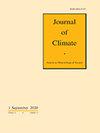The significance of the melt-pond scheme in a CMIP6 global climate model
IF 4.8
2区 地球科学
Q1 METEOROLOGY & ATMOSPHERIC SCIENCES
引用次数: 0
Abstract
Abstract The impact of melt ponds on sea-ice albedo has been observed and documented. In general circulation models, ponds are now accounted for through indirect diagnostic treatments (‘implicit’ schemes), or prognostic melt-pond parametrisations (‘explicit’ schemes). However, there has been a lack of studies showing the impacts of these schemes on simulated Arctic climate. We focus here on rectifying this using the general circulation model HadGEM3, one of the few models with a detailed explicit pond-scheme. We identify the impact of melt ponds on the sea ice and climate, and associated ice-ocean-atmosphere interactions. We run a set of constant forcing simulations for three different periods and show, for the first time, using mechanistically different pond-schemes can lead to very significantly different sea-ice and climate states. Under near-future conditions, an implicit scheme never yields an ice-free summer Arctic, whilst an explicit scheme yields an ice-free Arctic 35% of years and raises autumn Arctic air temperatures by 5 to 8 °C. We find that impacts on climate and sea ice depend on the ice state: under near-future and Last Interglacial conditions, the thin sea ice is very sensitive to pond formation and parametrisation, whilst during the Pre-Industrial, the thicker sea ice is less sensitive to the pond-scheme choice. Both of these two commonly-used parametrisations of sea-ice albedo yield similar results under pre-industrial conditions, but in warmer climates, lead to very different Arctic sea ice and ocean and atmospheric temperatures. Thus changes to physical parametrisations in the sea-ice model can have large impacts on simulated sea ice, ocean and atmosphere.融化池方案在CMIP6全球气候模式中的意义
融化池对海冰反照率的影响已经被观测和记录。在一般环流模式中,现在通过间接诊断处理(“隐式”方案)或预测熔池参数化(“显式”方案)来考虑熔池。然而,缺乏研究表明这些方案对模拟北极气候的影响。我们在这里着重于使用一般环流模型HadGEM3来纠正这一点,HadGEM3是为数不多的具有详细明确的池塘方案的模型之一。我们确定了融池对海冰和气候的影响,以及相关的冰-海-气相互作用。我们在三个不同的时期进行了一组恒定强迫模拟,并首次表明,使用不同的机械池塘方案可以导致非常不同的海冰和气候状态。在最近的未来条件下,一个隐含的方案永远不会产生一个无冰的北极夏季,而一个明确的方案会产生一个35%的无冰的北极年,并将北极秋季的气温提高5到8°C。我们发现对气候和海冰的影响取决于冰态:在近未来和末次间冰期条件下,薄海冰对池塘形成和参数化非常敏感,而在工业化前,厚海冰对池塘方案选择不太敏感。在工业化前的条件下,这两种常用的海冰反照率参数都产生了类似的结果,但在较暖的气候下,导致北极海冰、海洋和大气温度的差异很大。因此,海冰模式中物理参数的变化会对模拟的海冰、海洋和大气产生很大的影响。
本文章由计算机程序翻译,如有差异,请以英文原文为准。
求助全文
约1分钟内获得全文
求助全文
来源期刊

Journal of Climate
地学-气象与大气科学
CiteScore
9.30
自引率
14.30%
发文量
490
审稿时长
7.5 months
期刊介绍:
The Journal of Climate (JCLI) (ISSN: 0894-8755; eISSN: 1520-0442) publishes research that advances basic understanding of the dynamics and physics of the climate system on large spatial scales, including variability of the atmosphere, oceans, land surface, and cryosphere; past, present, and projected future changes in the climate system; and climate simulation and prediction.
 求助内容:
求助内容: 应助结果提醒方式:
应助结果提醒方式:


